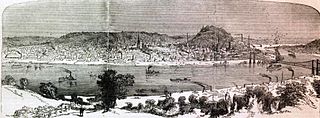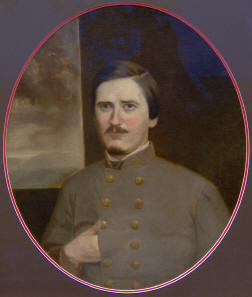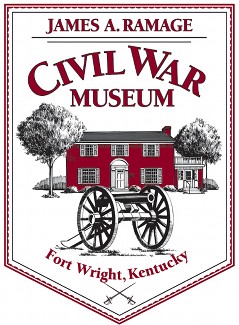Related Research Articles

Lewis Wallace was an American lawyer, Union general in the American Civil War, governor of New Mexico Territory, politician, diplomat, artist, and author from Indiana. Among his novels and biographies, Wallace is best known for his historical adventure story, Ben-Hur: A Tale of the Christ (1880), a bestselling novel that has been called "the most influential Christian book of the nineteenth century."

The Battle of Fort Donelson was fought from February 11–16, 1862, in the Western Theater of the American Civil War. The Union capture of the Confederate fort near the Tennessee–Kentucky border opened the Cumberland River, an important avenue for the invasion of the South. The Union's success also elevated Brig. Gen. Ulysses S. Grant from an obscure and largely unproven leader to the rank of major general, and earned him the nickname of "Unconditional Surrender" Grant.

The Battle of Perryville, also known as the Battle of Chaplin Hills, was fought on October 8, 1862, in the Chaplin Hills west of Perryville, Kentucky, as the culmination of the Confederate Heartland Offensive during the American Civil War. Confederate Gen. Braxton Bragg's Army of Mississippi initially won a tactical victory against primarily a single corps of Maj. Gen. Don Carlos Buell's Union Army of the Ohio. The battle is considered a strategic Union victory, sometimes called the Battle for Kentucky, since Bragg withdrew to Tennessee soon thereafter. The Union retained control of the critical border state of Kentucky for the remainder of the war.
The Army of the Ohio was the name of two Union armies in the American Civil War. The first army became the Army of the Cumberland and the second army was created in 1863.

William "Bull" Nelson was a United States naval officer who became a Union general during the American Civil War.

The siege of Corinth was an American Civil War engagement lasting from April 29 to May 30, 1862, in Corinth, Mississippi. A collection of Union forces under the overall command of Major General Henry Halleck engaged in a month-long siege of the city, whose Confederate occupants were commanded by General P.G.T. Beauregard. The siege resulted in the capture of the town by Federal forces.
The Orphan Brigade was the nickname of the First Kentucky Brigade, a group of military units recruited from Kentucky to fight for the Confederate States of America during the American Civil War. The brigade was the largest Confederate unit to be recruited from Kentucky during the war. Its original commander was John C. Breckinridge, former United States vice president, and Kentucky's former senator, who was enormously popular with Kentuckians.

The 1st Ohio Infantry Regiment was an infantry regiment in the Union Army during the American Civil War. It served in the Western Theater in a number of campaigns and battles.

The City-class ironclad USS Cincinnati was a stern-wheel casemate gunboat in the United States Navy during the American Civil War. She was named for Cincinnati, Ohio, and was the first ship to bear that name in the United States Navy.

The 41st Ohio Infantry Regiment was an infantry regiment in the Union Army during the American Civil War.

The Black Brigade of Cincinnati was a military unit of African-American soldiers, that was organized in 1862 during the American Civil War, when the city of Cincinnati, Ohio, was in danger of being attacked, by the Confederate Army. The members of the Cincinnati "Black Brigade" were among the first African Americans to be employed in the military defense of the Union. The fortifications—including forts, miles of military roads, miles of rifle pits, magazines, and hundreds of acres of cleared forests—at the border of Northern Kentucky thwarted the major threat to Cincinnati during the Civil War.
Shaler Battery was a hilltop earthwork fortification built during the American Civil War in Northern Kentucky by the Union Army to turn back invading Confederate troops. It was constructed to protect Cincinnati and the Ohio River valley. The location of this battery's powder magazine is marked by a bandstand in Evergreen Cemetery in Southgate, Kentucky.

The Defense of Cincinnati occurred during what is now referred to as the Confederate Heartland Offensive or Kentucky Campaign of the American Civil War, from September 1 through September 13, 1862. Confederate Brigadier General Henry Heth was sent north from Lexington, Kentucky, to threaten Cincinnati, Ohio, then the sixth-largest city in the United States. Heth was under orders from his superior, Major General Edmund Kirby Smith, not to attack the city, but to instead make a "demonstration". Once Heth arrived and reconnoitered the defenses, he realized an attack was pointless. After a few minor skirmishes, he took his men back to Lexington.

Seth Ledyard Phelps was an American naval officer, and in later life, a politician and diplomat. Phelps received his first commission in United States Navy as a midshipman aboard the famous USS Independence. He served patrolling the coast of West Africa guarding against slavers. During the Mexican–American War he served on gunboats, giving support to Winfield Scott's army, and later served in the Mediterranean and Caribbean squadrons.

During the American Civil War, the Ohio River port city of Cincinnati, Ohio, played a key role as a major source of supplies and troops for the Union Army. It also served as the headquarters for much of the war for the Department of the Ohio, which was charged with the defense of the region, as well as directing the army's offensives into Kentucky and Tennessee.

Graves' Artillery Battery, also known as [Kentucky] Issaquena Artillery Battery, was organized as a Confederate States Army artillery battery from Mississippi and Kentucky on November 8, 1861. During its formation, as a still understrength battery, the first commander was Captain Selden Spencer. In December, at Bowling Green, Kentucky, then Confederate Army Brigadier General (CSA) John C. Breckinridge chose Captain Rice E. Graves, Jr., as captain of the new battery to be attached to the 2nd Kentucky Infantry Regiment and assigned to his division. The unit was first assigned to Reserve, 1st Geographical Division, Department #2. Then the regiment was assigned to the Kentucky Brigade, Army of Middle Tennessee, Department #2 in October–November 1862. In November 1862, the regiment was assigned to the Kentucky Brigade, Breckinridge's Division, 1st Corps, Army of Tennessee in November 1862, nicknamed the "Orphan Brigade".

The James A. Ramage Civil War Museum sought to tell the untold story of Cincinnati, Ohio, and Northern Kentucky's involvement in the American Civil War. Although no battles occurred there, the people of the area resisted a push by the Confederate army in 1862. The museum was located in Fort Wright, Kentucky on the site of Hooper Battery. The museum grounds covered 17 acres (69,000 m2) and it displayed historical passages, stories, and memorabilia. It also paid homage to the Black Brigade of Cincinnati, Fern Storer's kitchen, and the history of the City of Fort Wright.

Charles Whittlesey was a soldier, geologist, historian, and an investigator of mounds relics of the United States. He is described by Ephraim George Squier and Edwin Hamilton Davis in their book Ancient Monuments of the Mississippi Valley as a "zealous investigator" in the field of "American antiquarian research."

The 4th Kentucky Infantry Regiment was an infantry regiment that served in the Confederate States Army during the American Civil War. It was part of the First Kentucky Brigade.

The Wallace Guards were an independent company of Ohio militia raised when Cincinnati was under attack from Confederates in September 1862. The hastily formed company served for one month, and were part of the Defense of Cincinnati.
References
- ↑ Ullrey, Brad, R. (2006). "The History of Battery Hooper". XXI: 56.
{{cite journal}}: Cite journal requires|journal=(help)CS1 maint: multiple names: authors list (link) - ↑ Smith, Stern; Stern, Joseph (1960). The Siege of Cincinnati. Historical and Philosophical Society of Ohio.